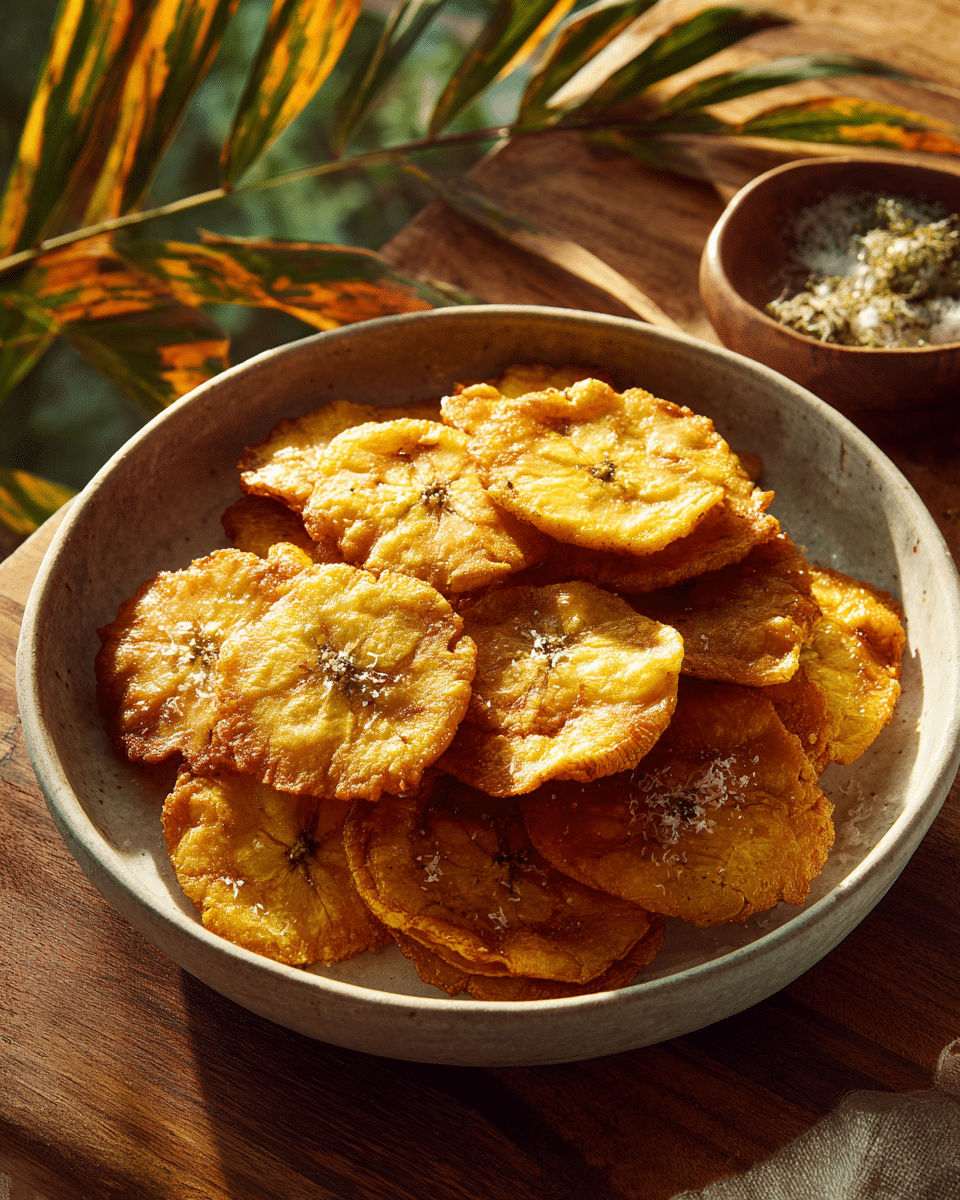Plantain tostones are a beloved staple across the Caribbean and Latin America. Made from green, unripe plantains, these crispy rounds are double-fried to golden perfection and lightly salted for a simple yet highly addictive snack or side dish. Their crunchy exterior and tender center make them a versatile companion to dips, seafood, or savory meats.
FULL RECIPE
Ingredients
- 2 large green plantains (unripe)
- Vegetable oil, for frying
- Kosher salt, to taste
- Optional: garlic salt or adobo seasoning for extra flavor
Directions
- Peel the plantains by cutting off the ends and slicing the skin lengthwise without cutting into the flesh. Use your fingers or a spoon to remove the peel.
- Slice the plantains into 1-inch thick rounds.
- Heat about 1 inch of oil in a deep skillet over medium heat until it reaches 350°F (175°C).
- Fry the plantain rounds in batches for about 3 minutes per side, or until they begin to soften and turn pale golden. Remove and drain on paper towels.
- Using a flat-bottomed glass or tostonera, gently press each plantain slice to flatten it to about 1/4 inch thick.
- Return the flattened plantains to the hot oil and fry again until crispy and golden brown on both sides, about 2–3 minutes per side.
- Remove and drain on paper towels. While still hot, sprinkle generously with kosher salt or your seasoning of choice.
- Serve immediately, optionally with a garlic mojo, aioli, or your favorite dipping sauce.
Nutrition Facts
- Calories: 180
- Total Fat: 10g
- Saturated Fat: 1g
- Cholesterol: 0mg
- Sodium: 150mg
- Total Carbohydrates: 24g
- Dietary Fiber: 2g
- Sugars: 1g
- Protein: 1g
- Potassium: 450mg
History and Cultural Significance of Tostones
Tostones have deep roots in Caribbean and Latin American cuisine, particularly in countries like Puerto Rico, the Dominican Republic, Cuba, and Colombia. These twice-fried green plantain slices have been a staple for centuries, offering a practical way to enjoy plantains before they fully ripen. Historically, tostones were an affordable, accessible food made from what was readily available, and they remain a cherished comfort food that connects modern diners with rich culinary traditions.
Choosing the Right Plantains for Tostones
The key to perfect tostones starts with selecting the right plantains. Green, unripe plantains are essential because they have a firmer texture and less sweetness compared to ripe yellow or black plantains. Their starch content makes them ideal for frying, allowing the slices to become crispy on the outside while maintaining a soft interior. Overripe plantains will not hold their shape during frying and tend to become mushy, so always aim for firm, green plantains with no yellow spots.
The Science Behind Double Frying
The iconic texture of tostones comes from the double-frying process. The first fry cooks the plantain through and softens it, while the second fry crisps it up to golden perfection. Pressing the plantain slices between fries creates a larger surface area, which increases crispiness. This method is similar to double-fried potatoes, allowing tostones to achieve a delightful contrast of crunchy exterior and tender inside.
Health Benefits of Plantains
While often associated with indulgent frying, plantains themselves are nutritious. They are rich in complex carbohydrates, dietary fiber, and essential vitamins such as vitamin C, vitamin A, and B vitamins. Plantains are also a good source of potassium, which supports heart health and muscle function. When prepared with minimal oil or baked alternatives, tostones can be part of a balanced diet, offering energy and vital nutrients.
Variations Across Different Regions
Tostones vary slightly across the regions where they are popular. In Puerto Rico, they are often served alongside mofongo, a mashed plantain dish, or with a garlic-based mojo sauce. In Cuba, tostones frequently accompany rice and beans or are topped with shredded meat. Some variations include seasoning the tostones with garlic powder, paprika, or even sprinkling them with cheese. These regional twists showcase the versatility of tostones as a side or snack.
Serving Suggestions and Pairings
Tostones are incredibly versatile and pair well with a wide range of foods and dips. They make an excellent side to grilled meats, seafood, and stews. Popular accompaniments include garlic mojo, cilantro-lime sauce, or a creamy avocado dip. For a more casual snack, they can be served with a simple squeeze of lime and salt. Their neutral flavor profile allows tostones to complement both savory and spicy dishes alike.
Storage and Reheating Tips
Because tostones are best enjoyed crispy and fresh, storage and reheating require some care. Leftover tostones should be stored in an airtight container in the refrigerator for up to two days. To re-crisp them, it’s best to reheat in a hot oven or toaster oven at 375°F (190°C) for 5 to 10 minutes rather than microwaving, which can make them soggy. Alternatively, a quick re-fry in hot oil will restore their crisp texture.
Making Tostones Healthier
For those seeking a healthier option, tostones can be baked or air-fried instead of deep-fried. This method significantly reduces the oil content while still achieving a pleasant crunch. Lightly brushing the flattened plantain slices with olive oil before baking helps mimic the fried texture. Additionally, seasoning with herbs and spices rather than salt can add flavor without increasing sodium intake.
Common Mistakes to Avoid When Making Tostones
One common mistake is using ripe plantains, which results in soggy or overly sweet tostones. Another pitfall is frying at too high or too low a temperature, which can cause the plantains to burn or absorb excess oil. Pressing the plantains too thin can also cause them to fall apart during the second fry. Ensuring the oil is hot enough and using a firm but gentle pressing method will yield the best results.
Tostones in Modern Cuisine
Today, tostones have transcended their humble origins to appear in gourmet and fusion cuisines worldwide. Chefs often use them as a base for creative toppings like ceviche, pulled pork, or avocado salsa. They also appear as trendy appetizers in Latin-inspired restaurants, showcasing their adaptability and enduring appeal. This evolution highlights how traditional recipes can be reimagined while honoring their cultural roots.
Conclusion
Tostones are much more than just fried plantains; they are a culinary tradition with rich cultural significance and delightful taste and texture. Their versatility allows them to be enjoyed in countless ways, from simple salted snacks to elaborate gourmet dishes. Whether prepared traditionally or with modern twists, tostones continue to captivate palates with their irresistible crispiness and satisfying flavor, making them a timeless favorite across the globe.






